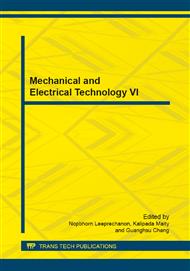[1]
Karlijn F. de Laat, Anil M Tuladhar, and Frank-Erik de Leeuw, Loss of white matter integrity is associated with gait disorders in cerebral small vessel disease, Brain, vol. 134, Issue 1, pp.73-87, January (2011).
DOI: 10.1093/brain/awq343
Google Scholar
[2]
Diana B. Welmerink, W. T. Longstreth, Mary F. Lyles, and Annette L. Fitzpatrick, Cognition and the Risk of Hospitalization for Serious Falls in the Elderly: Results From the Cardiovascular Health Study, Journals of Gerontology Series A: Biomedical Sciences and Medical Sciences, vol. 65A, Issue. 11, pp.1242-1249, June (2010).
DOI: 10.1093/gerona/glq115
Google Scholar
[3]
Minoru Yamada, Hidenori Arai, Kazuki Uemura, Shuhei Mori, Koutatsu Nagai, Buichi Tanaka, Yusuke Terasaki, Mamoru Iguchi, and Tomoki Aoyama, Effect of resistance training on physical performance and fear of falling in elderly with different levels of physical well-being, Age and Ageing, vol. 40, Issue. 5, pp.637-641, July (2011).
DOI: 10.1093/ageing/afr068
Google Scholar
[4]
Furui Wang, Duygun Erol Barkana, and Nilanjan Sarkar, Impact of Visual Error Augmentation When Integrated With Assist-as-Needed Training Method in Robot-Assisted Rehabilitation, IEEE TRANSACTIONS ON NEURAL SYSTEMS AND REHABILITATION ENGINEERING, VOL. 18, NO. 5, OCTOBER (2010).
DOI: 10.1109/tnsre.2010.2058127
Google Scholar
[5]
H.I. Krebs, B.T. Volpe, M.L. Aisen, and N. Hogan, Increasing productivity and quality of care : Robot-aided neuro-rehabilitation, Journal of Rehabilitation Research and Development, vol. 37, Issue. 6, pp.639-652, November/December (2000).
Google Scholar
[6]
Kai-Tai Song and Sin-Yi Jiang, Force-Cooperative Guidance Design of an Omni-Directional Walking Assistive Robot, 2011 IEEE International Conference on Mechatronics and Automation, August (2011).
DOI: 10.1109/icma.2011.5985842
Google Scholar
[7]
Bamberg, and Stacy J Morris, Gait Analysis Using a Shoe Integrated Wireless Sensor System, Information Technology in Biomedicine, Vol. 12, Issue. 4, pp.413-423, July (2008).
DOI: 10.1109/titb.2007.899493
Google Scholar
[8]
Bakhshi S, Mahoor MH, and Davidson BS, Development of a body joint angle measurement system using IMU sensors, 33rd Annual International Conference of the IEEE EMBS, pp.6923-6926, September (2011).
DOI: 10.1109/iembs.2011.6091743
Google Scholar
[9]
Mayu Okumura, Haruyuki Iwama, Yasushi Makihara, and Yasushi Yagi, Performance Evaluation of Vision-based Gait Recognition using a Very Large-scale Gait Database, Proc. 4th IEEE Int. Conf. Biometrics: Theory, Applications and Systems (BTAS), September (2010).
DOI: 10.1109/btas.2010.5634525
Google Scholar
[10]
Jacquelin Perry, and Judith Burnfield, Gait Analysis: Normal and Pathological Function-2nd Edition, SLACK Incorporated, February (2010).
Google Scholar
[11]
Su Hong Eom, Mun Suck Jang, Eung Hyuk Lee and Pyung Soo Kim, A METHOD FOR ESTIMATING JOINT ANGLES VALUE OF KNEE JOINT REHABILITATION ROBOT, ICIC Express Letters, Volume 8, Number 2, February (2014).
Google Scholar


